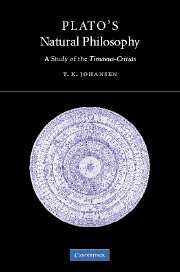Book contents
- Frontmatter
- Contents
- Acknowledgements
- Introduction: Plato's tales of teleology
- 1 What is the Timaeus-Critias about?
- 2 The status of the Atlantis story
- 3 The status of Timaeus' account
- 4 Teleology and craftsmanship
- 5 Necessity and teleology
- 6 Space and motion
- 7 Body, soul, and tripartition
- 8 Perception and cosmology
- 9 Dialogue and dialectic
- Epilogue
- Bibliography
- General index
- Index locorum
4 - Teleology and craftsmanship
Published online by Cambridge University Press: 03 September 2009
- Frontmatter
- Contents
- Acknowledgements
- Introduction: Plato's tales of teleology
- 1 What is the Timaeus-Critias about?
- 2 The status of the Atlantis story
- 3 The status of Timaeus' account
- 4 Teleology and craftsmanship
- 5 Necessity and teleology
- 6 Space and motion
- 7 Body, soul, and tripartition
- 8 Perception and cosmology
- 9 Dialogue and dialectic
- Epilogue
- Bibliography
- General index
- Index locorum
Summary
It is common to distinguish between two kinds of teleological account. One kind explains an outcome as the result of intentional agency. In this sense I might explain why I went to the circus by saying that I wanted to have fun. Another kind of teleological explanation does without intentions and posits goals without reference to thoughts or other intentional states. Aristotle's natural teleology is normally taken as an example of the latter, unintentional sort. In contrast, Plato's cosmology in the Timaeus is, with good reason, taken as an example of the intentional sort of teleology, or ‘unnatural’ teleology as James Lennox has called it.So at the beginning of his account Timaeus tells us that the cosmos was created by a craftsman, a ‘demiurge’ (Greek, dēmiourgos), who wanted to make the world as good and beautiful as possible (30a2–3). Throughout his account Timaeus reminds us that the demiurge made this or that feature of the cosmos as well as he could or that he made it in order that such-and-such an end should come about. The aim of this chapter is to examine the role of the demiurge in the creation of the cosmos in the light of this contrast between natural and unnatural teleology. I shall first consider Timaeus' reasons for introducing the demiurge. I then look at and reject some ways in which one might try to dispense with the demiurge when interpreting the Timaeus.
- Type
- Chapter
- Information
- Plato's Natural PhilosophyA Study of the Timaeus-Critias, pp. 69 - 91Publisher: Cambridge University PressPrint publication year: 2004



